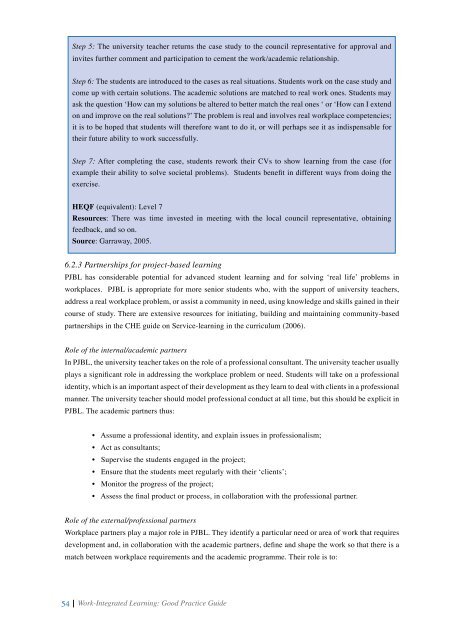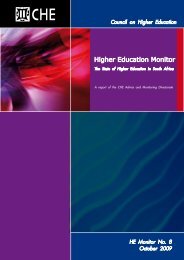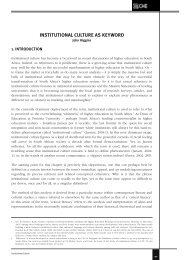Work-Integrated Learning: Good Practice Guide - CHE
Work-Integrated Learning: Good Practice Guide - CHE
Work-Integrated Learning: Good Practice Guide - CHE
You also want an ePaper? Increase the reach of your titles
YUMPU automatically turns print PDFs into web optimized ePapers that Google loves.
6.2.3 Partnerships for project-based learning<br />
PJBL has considerable potential for advanced student learning and for solving ‘real life’ problems in<br />
workplaces. PJBL is appropriate for more senior students who, with the support of university teachers,<br />
address a real workplace problem, or assist a community in need, using knowledge and skills gained in their<br />
course of study. there are extensive resources for initiating, building and maintaining community-based<br />
partnerships in the cHE guide on Service-learning in the curriculum (2006).<br />
Role of the internal/academic partners<br />
In PJBL, the university teacher takes on the role of a professional consultant. the university teacher usually<br />
plays a significant role in addressing the workplace problem or need. Students will take on a professional<br />
identity, which is an important aspect of their development as they learn to deal with clients in a professional<br />
manner. the university teacher should model professional conduct at all time, but this should be explicit in<br />
PJBL. the academic partners thus:<br />
54<br />
Step 5: the university teacher returns the case study to the council representative for approval and<br />
invites further comment and participation to cement the work/academic relationship.<br />
Step 6: the students are introduced to the cases as real situations. Students work on the case study and<br />
come up with certain solutions. the academic solutions are matched to real work ones. Students may<br />
ask the question ‘How can my solutions be altered to better match the real ones ‘ or ‘How can I extend<br />
on and improve on the real solutions?’ the problem is real and involves real workplace competencies;<br />
it is to be hoped that students will therefore want to do it, or will perhaps see it as indispensable for<br />
their future ability to work successfully.<br />
Step 7: After completing the case, students rework their cVs to show learning from the case (for<br />
example their ability to solve societal problems). Students benefit in different ways from doing the<br />
exercise.<br />
HEQF (equivalent): Level 7<br />
Resources: there was time invested in meeting with the local council representative, obtaining<br />
feedback, and so on.<br />
Source: garraway, 2005.<br />
• Assume a professional identity, and explain issues in professionalism;<br />
• Act as consultants;<br />
• Supervise the students engaged in the project;<br />
• Ensure that the students meet regularly with their ‘clients’;<br />
• Monitor the progress of the project;<br />
• Assess the final product or process, in collaboration with the professional partner.<br />
Role of the external/professional partners<br />
<strong>Work</strong>place partners play a major role in PJBL. they identify a particular need or area of work that requires<br />
development and, in collaboration with the academic partners, define and shape the work so that there is a<br />
match between workplace requirements and the academic programme. their role is to:<br />
<strong>Work</strong>-<strong>Integrated</strong> <strong>Learning</strong>: <strong>Good</strong> <strong>Practice</strong> <strong>Guide</strong>






